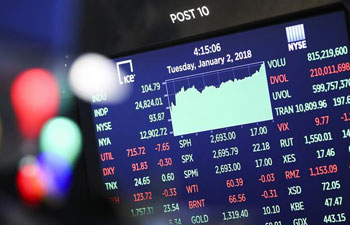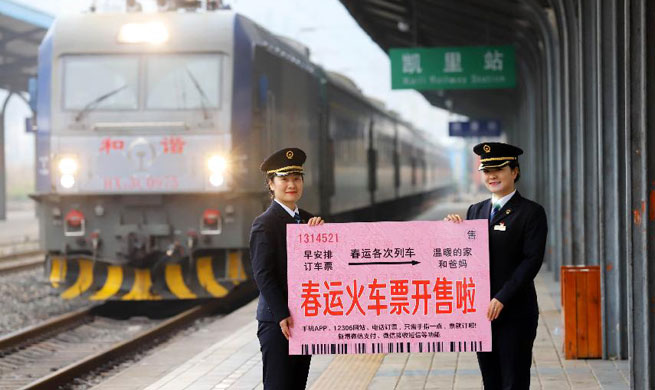KUALA LUMPUR, Jan. 3 (Xinhua) -- Malaysia has been seen as a key investment destination for Chinese companies. The trend is expected to pick up momentum in the new year.
PROJECTS TO WATCH
In 2017, several deals that involved Chinese firms have been finalized. In March, the Digital Free Trade Zone (DFTZ), led by Alibaba Group, was launched to boost Malaysia's e-commerce.
In June, Zhejiang Geely Holdings purchased a 49.9- percent stake in Malaysian national car maker Proton, before the Malaysian government launched the East Coast Rail Link (ECRL) in August, which has China Communications Construction Company as the main contractor, to improve connectivity in the country.
With these projects entered execution phase this year, it is set to continue to steal the limelight in Malaysia.
The most anticipated could probably be the DFTZ, which set to transform the landscape of Malaysia's retail and logistic sector.
The Malaysian government has set an ambitious target by boosting e-commerce growth rate to 20.8 percent from 10.8 percent, and to increase e-commerce contribution to gross domestic product by 211 billion ringgit (52.5 billion U.S. dollars) by 2020.
"We expect Malaysian businesses to invest in automation, new business opportunities and embrace new technologies to cope with the change in the industry trends," CIMB Research said in its recent report on the DFTZ.
Another key thing to watch this year is the reform of Proton, whether Geely can turn the loss making firm into a profitable entity. Proton's new Chinese chief executive Li Chunrong has targetted a gradual reduction in Proton's losses and breakeven in three to four years.
"We expect Geely to help drive Proton's turnaround following the appointment of a new management team at Proton's production, operation, manufacturing and marketing divisions," said CIMB's Mohd Shanaz Noor Azam, noting that the new management is focusing on cost optimization to improve immediate operating efficiency and financial performance.
He also sees the timetable to breakeven as achievable since more cross-platform models between Proton and Geely are expected, which will expedite new model introduction and help Proton lower its product development costs, he added.
Besides, he expects Proton to benefit from Geely's latest technology as the latter intends to supply the latest engine and energy solutions to Proton.
Meanwhile, Malaysia's construction sector is likely to remain "hot" as ECRL, the new railway project, is set to award work packages.
"Among the mega projects that have been announced, the ECRL is at the most advanced stage of planning," said UOB Kay Hian's analyst Ridhwan Effendy in his report Wednesday.
The awards to local contractors are expected to take place in early 2018, which would add to at least 16 billion ringgit in construction jobs for local players, he added.
Apart from ECRL, Maybank Investment Bank Research sees Chinese contractors to continue to participate in other major infrastructure projects, either directly or via joint ventures with Malaysian partners. Chinese contractors are expected to involve in projects such as Klang Valley Mass Rapid Transit 3 and Kuala Lumpur to Singapore High Speed Rail
CLOSER ECONOMIC TIES
Economists expect the economic relationship to further improve over years.
"Malaysia is well-positioned to benefit from the higher connectivity due to its central location for sea, air and land transportation, favorable policy environment and strong capacity to absorb foreign investment inflows," Sunway University Economics professor Yeah Kim Leng told Xinhua.
While there have been concerns over low spillover effects to the economy, Yeah opined that the positive benefits of Chinese investment for Malaysian economy will include expansion of production, export and infrastructure capacity.
Besides, Chinese investment also offer more diversified sources of inward foreign direct investment (FDI), and increased access to Chinese markets for Malaysian manufacturers and service providers as the economic and business linkages expand over time, said Yeah.
"Given that both the Association of Southeast Asian Nations (ASEAN) and China are expected to continue to grow at a healthy pace, there are certainly further areas for growth," said Edward Lee, the chief economist for Southeast Asia at Standard Chartered.
"Consumer markets in both economic areas will grow larger and provide final demand for companies in both economies," he told Xinhua.
As Chinese companies diversify their assets, he also expects the increasing outward direct investments into the region.
"There has been an increase in investments from China into the region, more so in real estate and construction sectors. But as China develops further, there may be increasing investments in other areas," Lee said.
BIGGER ROLE OF RENMINBI
Economists also believe the expansion of China in regional trades and economic ties will encourage the usage of Renminbi (RMB), the Chinese yuan, in Malaysia.
"Greater foreign direct investment inflows from China and initiatives such as the DFTZ are likely to promote more two-way trade and investment flows between Malaysia and China," CIMB Investment Bank economic research head Michelle Chia told Xinhua.
Ultimately, the willingness of businesses in Malaysia to integrate the usage of Renminbi for cross-border should improve, she said.
She sees the continuation of Renminbi's liberalization, expansion of China's domestic Renminbi products and services and greater global Renminbi liquidity that lower the costs and risks of Renminbi settlement, as three key drivers to promote Renminbi usage.
Chia also highlighted the internationalization of Renminbi is likely to increase over the long term, in line with the growing weight of China's economy in global commerce and financial markets.
As the Belt and Road Initiative gains traction, she believed the expansion of trade and investment links between China and its neighboring regions, including Malaysia, will encourage further adoption of the Renminbi.
Proposed in 2013, the Belt and Road Initiative aims to build trade and infrastructure networks connecting nations on and beyond the ancient Silk Road routes.
It comprises the Silk Road Economic Belt and the 21st Century Maritime Silk Road. Malaysia is one of the first countries that supported the initiative.
Chia opined that Chinese policymakers are also progressively building the financial infrastructure such as offshore Renminbi clearing centers, deeper Renminbi bond markets, and the push for inclusion of the Renminbi in the special drawing right basket, as companies in China look outwards for growth.
"As China expands in trade and deepens economic ties in the region, this will promote further Renminbi usage," United Overseas Bank (Malaysia)'s economist Julia Goh told Xinhua.
Concurred with Chia, she said, the Belt and Road Initiative will promote wide use of the Renminbi and increase other local currency-denominated funding, as the Chinese government has committed to help fund overseas businesses under the initiative.
However, it may still need time to see more usage of Renminbi as U.S. dollar remain dominated world payments currency.

















